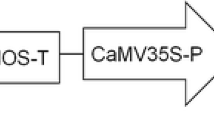Abstract
Chinese lawngrass (Zoysia sinica Hance) is a warm-season turfgrass, which is widely used for golf courses, athletic fields and home lawns. In order to improve Chinese lawngrass with biotechnology, an efficient plant regeneration system was established. Five highly regenerable callus lines have been developed by addition of 6-benzylaminopurine (6-BA) and adjusting concentration of 2,4-dichlorophenoxyacetic acid (2,4-D) in culture medium after multiple subculture, of which callus line Zh44 was used for Agrobacterium-mediated transformation. The gene, encoding C-repeat/dehydration-responsive element binding factor 1 (CBF1/DREB1b) from Arabidopsis driven by cauliflower mosaic virus (CaMV) 35S promoter, was introduced into Chinese lawngrass under selection using the bar gene with glufosinate. Three independent transgenic lines were successfully obtained using a three-step selection/regeneration procedure. The transgenic plants were confirmed by polymerase chain reaction (PCR), southern blot and reverse transcriptase polymerase chain reaction (RT-PCR) analyses. Two transgenic lines exhibited growth retardation and decreased tillering. The transgenic lines have a significantly stronger chilling tolerance than that of wild type plants, measured by ion leakage, total chlorophyll content and yellowed leaf rate in chilling conditions.
Similar content being viewed by others
Abbreviations
- AS:
-
acetosyringone
- 6-BA:
-
benzylaminopurine
- CBF1 :
-
C-repeat/dehydration-responsive element binding factor 1
- 2,4-D:
-
2,4-dichlorophenoxyacetic acid
- MS:
-
Murashige and Skoog medium
- NAA:
-
naphthaleneacetic acid
- PCR:
-
polymerase chain reaction
- RT-PCR:
-
reverse transcriptase polymerase chain reaction
References
AL-Khayri JM, Huang FH, Thompson LF, King JW (1989) Plant regeneration of zoysiagrass from embryo-derived callus Crop Sci. 29: 1324–1325
Asano Y (1989) Somatic embryogenesis and protoplast culture in Japanese lawngrass (Zoysia japonica)Plant Cell Rep. 8: 141–143
Asano Y, Katsumoto H, Inokuma C, Kaneko S, Ito Y, Fujiie A (1996) Cytokinin and thiamine requirements and stimulative effects of riboflavin and α-ketoglutaric acid on embryogenic callus induction from the seeds of Zoysia japonica Steud J. Plant Physiol. 149(3–4): 413–417
Deak M, Horvath GV, Davletova S, Torok K, Sass L, Vass I, Barna B, Kiraly Z, Dudits D (1999) Plants ectopically expressing the iron-binding protein, ferritin, are tolerant to oxidative damage and pathogens Nat. Biotechnol. 17: 192–196
Diesburg KL (2000) Expanded germplasm collections set stage for increased zoysiagrass breeding for turf use Diversity 16(1–2): 49–50
Engelke MC (2000) Widely used for centuries, zoysiarass is a time-tested reservoir of genetic diversity Diversity 16(1–2): 48–49
Fowler S, Thomashow MF (2002) Arabidopsis transcriptome profiling indicates that multiple regulatory pathways are activated during cold acclimation in addition to the CBF cold response pathway Plant Cell 14: 1675-1690
Gilmour SJ, Sebolt AM, Salazar MP, Everard JD, Thomashow MF (2000) Overexpression of the Arabidopsis CBF3 transcriptional activator minics multiple biotechnical changes associated with cold acclimation Plant Physiol. 124, 1854–1865
Hsieh TH, Lee JT, Yang PT, Chiu LH, Charng YY, Wang YC, Chan MT (2002) Heterology expression of the Arabidopsis C-repeat/dehydration response element binding factor 1 gene confers elevated tolerance to chilling and oxidative stresses in transgenic tomato Plant Physiol. 129(3): 1086–1094
Jaglo KR, Kleff S, Amundsen KL, Zhang X, Haake V, Zhang JZ, Deits T, Thomashow MF (2001) Components of the Arabidopsis C-repeat/dehydration-responsive element binding factor cold-response pathway are conserved in Brassica napus and other plant species Plant Physiol. 127: 910–917
Jaglo-Ottosen KR, Gilmour SJ, Zarka DG, Schabenberger O, Thomashow MF (1998) Arabidopsis CBF1 overexpression induces COR genes and enhances freezing tolerance Science 280(5360): 104–106
Kanaya E, Nakajima N, Morikawa K, Okada K, Shimura Y (1999) Characterization of transcriptional activator CBF1 from Arabidopsis thaliana J. Biol. Chem. 274: 16068–16076
Lee SC, Huh KW, An K, An G, Kim SR (2004) Ectopic expression of a cold-inducible transcription factor, CBF1/DREB1b, in transgenic rice (Oryza sativa L.) Mol. Cells 18(1): 107–114
Li L, Qu R (2004) Development of highly regenerable callus lines and biolistic transformation of turftype common bermudagrass [Cynodon dactylon (L.) Pers.] Plant Cell Rep. 22(6): 403–407
Li RF, Zhang JY, Zhao ML (2003) Plant regeneration and callus induction of zoysiagrass (Zoysia japonica Steud.) Acta Hort. Sinica 30(3): 355–357
Murashige T, Skoog F (1962) A revised medium for rapid growth and bioassays with tobacco tissue culture Physiol. Plant 15: 473–479
Marcum KB, Anderson SJ, Engelke MC (1998) Salt gland ion secretion: a salinity tolerance mechanism among five zoysiagrass species Crop Sci. 38: 806–810
Murray MG, Thompson WF (1980) Rapid isolation of high-molecular-weight plant DNA Nucl. Acids Res. 8: 4321–4325
Sambrook J, Fritsch E, Maninatis T (1989) Molecular Cloning Cold Spring Harbor Laboratory Press, Cold Spring Harbor, New York, pp. 499–502
Stockinger EJ, Gilmour SJ, Thomashow MF (1997) Arabidopsis thaliana CBF1 encodes an AP2 domain-containing transcriptional activator that binds to the C-repeat/DRE, a cis-acting DNA regulatory element that stimulates transcription in response to low temperature and water deficit PNAS 94: 1035–1040
Toyama K, Bae CH, Kang JG, Lim YP, Adachi T, Riu KZ, Song PS, Lee HY (2003) Production of herbicide-tolerant zoysiagrass Agrobacterium-mediated transformation Mol. cells 16(1): 19–27
Zhen W, Chen X, Sun SY, Hu YL, Lin ZP (2000) Identification of cold tolerance and transformation of canola and tobacco with a cold-inducible transcription factor, CBF1 Prog. Natl. Sci. 10(12): 1104–1108
Acknowledgments
This work was supported by the State ‘863’ High-Tech Program (Grant No. 2002AA241061) and in part by National Natural Science Foundation of China (Grant No. 30370856). We are also grateful to Dr. Zhen-bo Tan for providing Agrobacterium strain and binary vector pBPCBF1bar for the study.
Author information
Authors and Affiliations
Corresponding author
Rights and permissions
About this article
Cite this article
Li, Rf., Wei, Jh., Wang, Hz. et al. Development of highly regenerable callus lines and Agrobacterium-mediated transformation of Chinese lawngrass (Zoysia sinica Hance) with a cold inducible transcription factor, CBF1 . Plant Cell Tiss Organ Cult 85, 297–305 (2006). https://doi.org/10.1007/s11240-006-9080-8
Received:
Accepted:
Published:
Issue Date:
DOI: https://doi.org/10.1007/s11240-006-9080-8




